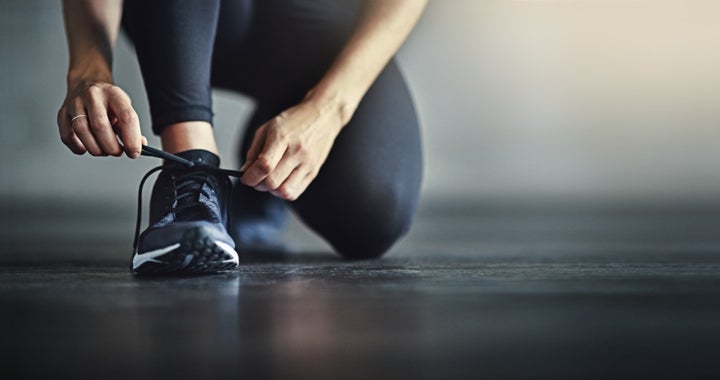
If you’re new to running, the idea of strapping on a pair of shoes and pounding the pavement for a solid half-hour can be extremely daunting. And the thought of logging 26.2 miles alongside a sea of enthusiastic marathon participants may seem like an impossible dream. But that doesn’t mean it’s not doable.
“Anybody can be a runner,” former “Biggest Loser” trainer Jillian Michaels told HuffPost. “It’s just a matter of easing into the sport, slowly building up your endurance, and properly training.”
Little changes ― from your stance to your shoes ― can make all the difference when it comes to upping your running game. Here are a few ways you can catapult yourself from beginner status to seasoned runner, according to experts.
1. Start slow.
“Don’t expect to run five miles on day one if you’ve never run before or it’s been a while,” said Melissa Merritt, a personal trainer based in Los Angeles. To ease into the sport, she recommended making a schedule and sticking with it.
“Being consistent will help you to build up your endurance and make sure you’re setting yourself up for success,” Merritt explained.
Merritt tells her clients to be kind to themselves and to look past the tough days. “Small steps can really add up,” she said, noting that “some days will be great and others might suck, but as long as you have more good days and overall enjoy the process, stick with it and it will get easier.”
2. Run with proper form.
“It always starts with form when it comes to exercise, because poor form creates injuries,” Michaels said. Here are her recommendations for a proper running stride:
Don’t let your arms cross your body.
“You want your hands to be like little T. rex hands, thumbs up, pinky down,” she explained. “Your hands should rest right above your hip bone because if they are a little higher than that, it can elevate your heart rate because your body is trying to send blood up into your arms, and it can make your biceps and shoulders tired. So arms should be relaxed at your side moving front to back, not swinging side to side or across the body.”
Strike on the balls of your feet.
“The old-school methodology of striking on the heel is actually completely counterintuitive, and much more recent studies in biomechanics show us that when you put your heel forward, it’s a breaking movement,” Michaels said.
She added that placing your foot down incorrectly can send stress up the leg, through the knee, and into the hip and lower back. “Opt for a slight forward lean, and you want to act as though you are griping the ground with your feet, so you are striking on the ball of your foot,” she said.
3. Start with a run/walk.
Don’t just dive into an all-or-nothing running session; it’s OK to start slow and mix running and walking.
“You start with two minutes on, five minutes off, and you gradually build yourself up to a five-minute jog and then two minutes off, and then you start to jog for longer and longer periods of time,” Michaels said.
Following this type of program will help your body slowly develop cardiovascular conditioning, and will help you avoid injury from pushing too hard too soon, she added.
4. Master your breath.
Megan Graff, a USA Track and Field Level 1 running coach, said the key is taking sufficiently deep breaths in order to maximize the oxygen fuel for the body.
“If you’re depriving your body by taking shorter, shallower breaths, you’re going to feel wiped out sooner,” she explained.
Austin Misiura, a certified strength and conditioning specialist and owner of Pure Physical Therapy in Miami, recommended diaphragm breathing.
“As you inhale, your belly should expand out, like a balloon,” Misiura said. “When you exhale, exhale forcefully and think of pushing all the air out of the balloon from all sides.”
Lindsay McClelland, who has completed 13 marathons, added that when you’re first starting out, you should stay at a conversational pace with slow and steady breathing.
“If you can’t talk while you’re running, you’re probably not breathing well and you’re probably going too fast,” McClelland said.
5. Get the right shoes.
Don’t just go into the store and buy the fanciest kicks that catch your eye; opt for footwear that will enhance your running experience.
“Have the shoe store do a gait analysis, which is a fancy way of saying they watch you walk/run, and recommend shoes based on the results,” said Joseph Sudimack, a physical therapy technology program director at Carrington College in California. “If you purchase shoes that do not adequately support your arches, injuries can arise.”
Ruggero Loda, founder of the site Running Shoes Guru, added that it’s important to select shoes that are comfortable. His rule of thumb is to make sure your sneakers fit correctly and that you can dart around in them without any uncomfortable friction.
“You are going to spend hundreds of miles in those shoes with sweaty feet,” Loda explained. “If they are not comfortable when you try them on, don’t start running in them.”
6. Set a tangible goal.
According to Michaels, one of the best ways to ensure that you improve at running is to lock yourself into an upcoming entry-level race.
“Pick a cause that is important to you, whether it’s raising money to fight breast cancer or AIDS,” she said. “Have a specific date, a very defined goal. Let people know you are doing it, commit yourself emotionally, sign yourself up, and raise funds.”
Michaels, who recently launched a beginners running training program on her app, noted that it’s entirely reasonable for a complete running novice to be ready for a 5,000-meter race in two months.
“Another way to hold yourself accountable and to arm yourself with emotional support is to join a running group,” she said.
7. Mentally prepare to become a runner.
Joan Scrivanich, a running and triathlon coach with Rise Endurance, pointed out that mental training can tremendously improve your pavement-pounding performance.
“Henry Ford had it right when he said, ‘Whether you think you can, or you think you can’t ― you’re right.’ The mind and body are connected and higher confidence levels leads to better performance,” Scrivanich said.
This mentality explains why athletes often perform better after visualizing a task, such as weightlifting, before executing it.
8. Work on your strength training.
In order to prevent injuries and excel at running, it’s important to keep your body strong, according to Rachel Straub, co-author of Weight Training Without Injury.
“Overall, one of the best things you can do to become a better runner is to ensure you incorporate strength training exercises into your routine,” Straub said.
The knee is the most common injury site among runners, and poor hip strength is a primary cause.
“When your hips are weak, this increases loading at the knee,” Straub said. She recommended exercises such as side steps using a resistance band, bridges, squats and hip extensions.
In order to prevent injuries such as shin splints, Michaels tells her clients to do ankle extensions.
“If you don’t have access to a gym, you can hook a band around the leg of your sofa, pull it forward, wrap it around the top of your foot and practice pointing and flexing,” Michaels said. “That or even just a simple hold in regards to flexion where you pull your toes back and squeeze the front of your shins works as well.”
9. Stay flexible.
Michaels is a big proponent of properly stretching following a run. The trainer recommends calf stretches with your heel hanging off a step, or utilizing a wall to push your toes backward in order to feel it in your calf.
Karena Wu, owner of ActiveCare Physical Therapy in New York and in Mumbai, also suggested runners take the time to do some static stretches to help increase flexibility for the long run and slow the heart rate down.
“This means less tightness and soreness after exercise because it can help move the lactic acid out of the muscle tissues,” Wu noted.
10. Factor in recovery time.
While training is key to becoming a better runner, it’s also important to take days off to relax both mentally and physically.
“One of the most important things people overlook when working out is recovery time,” said Mirinda Carfrae, a professional triathlete and three-time Ironman Triathlon world champion. “Regardless if you are starting out with a training routine or are a seasoned pro, the magic happens when you can really maximize your recovery based directly off your training effort. Making sure your muscles recover is just as important to progress as working them out.”
11. Don’t overexert yourself.
“There’s no rhyme or reason to it, some days are just hard,” said Justin Craig, co-owner of Michigan running specialty shop, RUNdetroit.
The key is to keep going, but to also listen to your body and not push past your ability.
“Do what you can to adapt,” Craig said. “Sometimes that’s slowing down or cutting a run short. Listen to your body and avoid the ‘finish by any means’ mentality. Pushing yourself when you’re not ready is a recipe for injury.”
12. Maintain an overall healthy lifestyle.
Keeping in good health is important to enhancing your exercise performance.
“Staying hydrated is key,” Merritt said. She also tells her clients to eat a balanced diet and make sure that they are getting enough sodium and potassium to replace what’s lost through sweating.
It’s also important to prioritize a full seven or eight hours of sleep a night.
“Sleep also helps runners in other ways,” said Chris Brantner, a certified sleep science coach at Sleep Zoo. “For example, deep sleep is necessary for recovery and muscle building, as growth hormone is released and broken tissue recovers and regenerates during this phase.”
Now go out and conquer the pavement!
